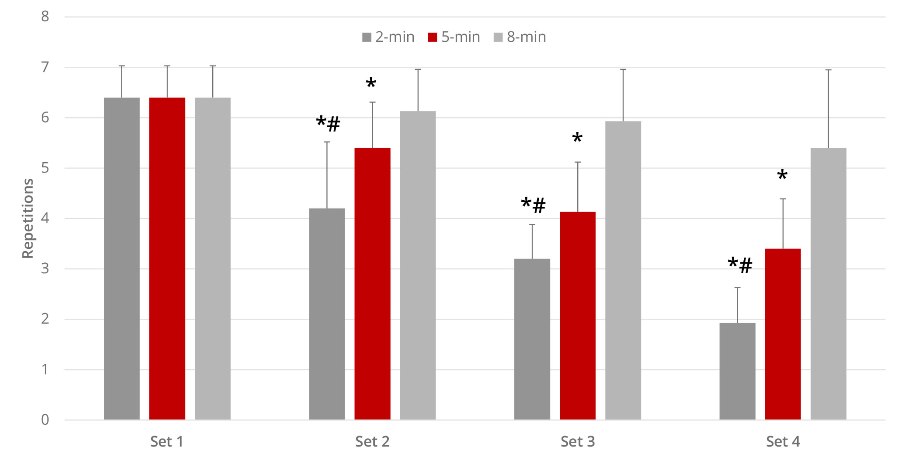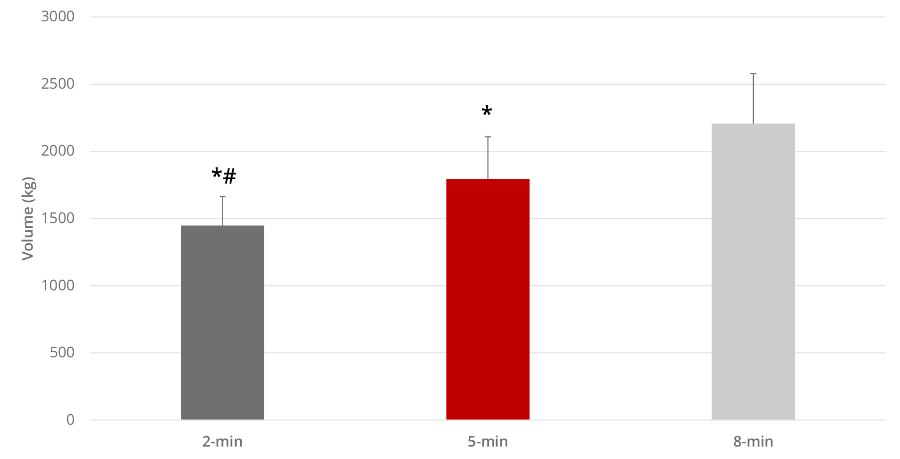
Strength and muscle hypertrophy are the main benefits of resistance training. However, for training to be successful and to optimise the expected results, it is essential to understand and know how to manipulate numerous variables such as the frequency, volume, intensity, load, choice and order of exercises, speed of execution, type of contraction, training to failure or not, range of motion and rest interval between sets.
Muscle hypertrophy and strength are dose-dependent on training volume. This is usually determined by the product of the number of sets, repetitions and the load used. However, the number of sets and repetitions performed is itself affected by the fatigue accumulated from the previous set. Thus, rest interval is an important variable as it determines the number of repetitions an athlete will be able to perform in the next set. Generally, the number of repetitions drops which is caused by a too short recovery period. This leads to a partial renewal of energy reserves and the accumulation of certain metabolites. For hypertrophy and strength, the rest interval times often recommended differ, with the longest being prescribed for strength gains. However, very few studies have tested recovery times longer than 5 minutes. And most literature on the subject recommends 2-3 minutes of rest. What impact will longer rest intervals have on training volume?
To answer this question, American researchers chose to compare 3 different rest intervals during a bench press workout and their impact on the training volume. To do this, the researchers recruited 15 bodybuilders (1RM = 108 ± 13; 1RM/body mass = 1.39 ± 0.1). During a first session, all the participants evaluated their 1RM. They then participated in 3 sessions, each separated by at least 48 hours. During each session, the participants carried out a bench press workout consisting of 4 sets to failure with a rest interval that differed according to the session: 2, 5 and 8 minutes.
The main results of this study show that during a bench press workout with muscle failure, the greater the interval rest, the less the decrease in the number of repetitions in the sets. The number of repetitions in sets 2, 3 and 4 is significantly smaller for rests of 2 and 5 minutes, while no significant difference was observed with a rest of 8 minutes (see fig. 1).

Figure 1. Evolution of repetitions according to sets and rest interval duration. *Significatively different from 8-min (p<0.05). #Significatively différent from 5-min (p<0.05).
Furthermore, the 8-minute inter-set rest allowed the highest training volume with a significant difference from the 2 and 5-minute rests (see Fig. 2).

Figure 2. Total training volume. *Significatively different from 8-min (p<0.05). #Significatively différent from 5-min (p<0.05).
One of the reasons that the longer inter-set rest allows for a higher number of repetitions to be maintained in each set is metabolic in origin with more complete resynthesis of energy substrates, greater oxygenation and buffering/removing of proton ion accumulation.
This study shows that it is possible to benefit from positive effects on performance with rest interval longer than those generally recommended. This is probably due to better metabolic recovery. Here, 8 minutes of rest allows the repetitions on each set to be maintained at 85% of 1RM at failure, whereas with 2 or 5 minutes, a significant decrease appears on each set.
Obviously, one of the first questions that arises is whether in the mid- or long-term, such a long rest would be better in terms of gains in strength or muscle mass. We will have to wait for a randomised controlled longitudinal study with advanced resistance-trained men and women. It would be tempting to say "yes", since this way of training allows for an increase in volume. However, 8 minutes of rest between each set implies a rather important time to spend on an exercise (here, approximately 25-26 minutes for 4 sets). But it is of course also possible to imagine sessions where the focus would be on one major exercise with long inter-set rest times and some accessory exercises where the inter-set rest times would be much shorter. The idea would then be to give priority to quality over quantity. For a given session time, what would you prefer to do ?
We remind you that you can quote articles by limiting your quotation to 200 words maximum and you must include a nominative link to this one. Any other use, especially copying in full on forum, website or any other content, is strictly prohibited. In doubt, contact us.
Copyright © 2011-2024 - www.sci-sport.com - All rights reserved